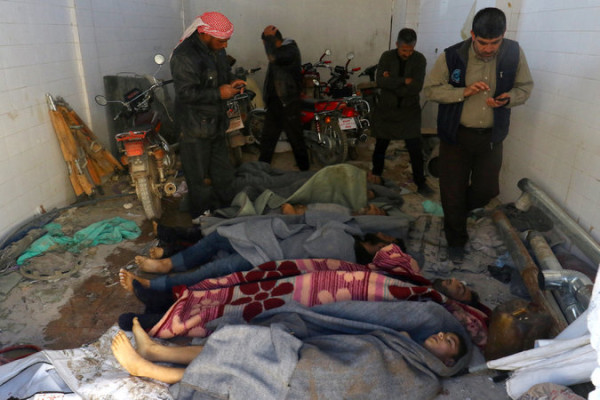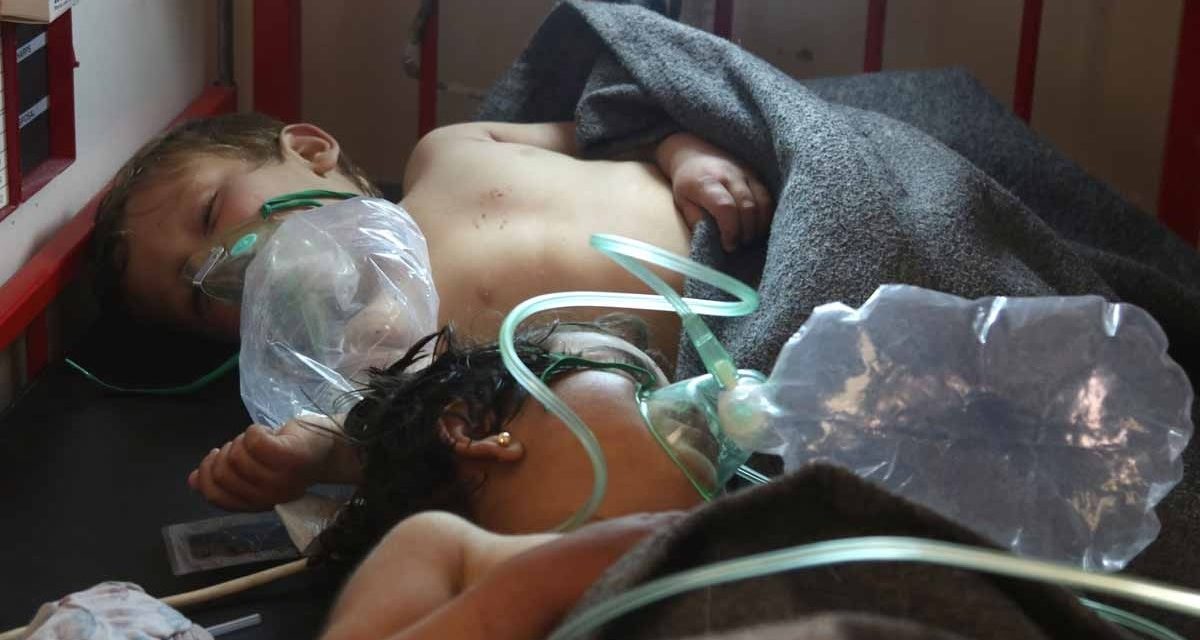Witnesses and videos document Assad regime’s chemical attack as international community considers response
LATEST
- Video: Pro-Assad Forces Firing Rockets from “Safe Haven” in Northern Hama
- Hay’at Tahrir al-Sham Tries to Kill Leading Rebel Commander
UPDATE 1900 GMT: Donald Trump, reading from a statement at a press conference alongside Jordan’s King Abdullah II, says the “horrific” “heinous actions” by the Assad regime “cannot be tolerated”.
The President said the chemical attack “crossed a lot of lines for me” and so his attitude towards “Syria and Assad has changed very much”.
Asked if the US will act against Assad, Trump said, “You will see.”
At a Security Council session, US Ambassador Nikki Haley — holding up pictures of children who died in the attack — said action will to be taken outside the UN if necessary, and Defense Secretary James Mattis said, “[This] was a heinous act and will be treated as such.”
UPDATE 1645 GMT: Father Abdul Hamid Youssef holds his twins, Ahmed and Aiya, killed along with 16 other members of his family on Monday:

UPDATE 1530 GMT: Médecins Sans Frontières says, from examination of eight patients and accounts of medical staff, that the attack on Khan Sheikhoun likely used a “hybrid” of a nerve agent and chlorine.
MSF said the victims had “symptoms consistent with exposure to chemical substances…[and] a neurotoxic agent like sarin gas”.
Symptoms incl. muscle spasms constricted pupils & involuntary defecation, consistent w/ exposure to a neurotoxic agent like sarin gas (4/7)
— MSF International (@MSF) April 5, 2017
Medics reported the patients smelling of bleach, “suggesting they had been exposed to chlorine”. Thus, “medical reports strongly suggest that victims of the attack on Khan Sheikhoun were exposed to a at least two chemical agents”.
UPDATE 1245 GMT: Iran has finally issued a statement on the chemical attacks, condemning any use “regardless of the perpetrators”.
Foreign Ministry spokesman Bahram Qassemi said the incident showed the need to combat “terrorist groups” and said the attack was an attempt to disrupte the political process.
The attack on Khan Sheikhoun in southern Idlib Province occurred about 6:30 a.m. A local doctor and then the Union of Medical Care Organizations, a coalition of international aid agencies that funds hospitals in Syria, put out the rising toll of deaths and injuries.
See initial summary, pictures, and videos in Syria Developing: 58+ Killed in Assad Regime’s Latest Chemical Attacks
Rescuers tried to save people in the streets by hosing off the chemical agent from clothing and skin. However, victims — many of them children — died on the spot, half-undressed after the failed attempt at revival, or in Khan Sheikhoun’s only clinic.
A 14-year-old resident, Mariam Abu Khalil, said she was walking to school when she saw an aircraft drop a bomb on a one-story building, raising a yellow mushroom cloud that stung her eyes. As she sheltered in her home, she saw several people arrive by car to help the wounded: “When they got out, they inhaled the gas and died.”
Mohammad Nejdat Youssef, 23, ran into “a winter fog — not quite yellow but not quite white” as he neared the site to rescue victims. He started to lose his balance, his eyes stung, his nose began to stream, and he started foaming at the month. He recovered after local treatment, but his pregnant wife and nephew were taken to Turkey for treatment after being caught in the cloud when it moved downwind.
The rescue attempt was further hindered in what appeared to be a coordinated effort to destroy any medical services. The clinic was hit by up to eight strikes:
The attack on the clinic, in the civil defense building:
The regime has regularly carried out chemical attacks, despite the supposed handover of all chemicals after its August 2013 use of sarin near Damascus that killed more than 1,400 people. Chlorine has been since spring 2014, and increasingly in recent months, on opposition areas in Hama, Aleppo, and Idlib Provinces. An attack near ISIS-held Palmyra in central Syria killed at least 85 people.
However, Monday’s attack — through munitions dropped from an Su-22 warplane, according to some local sources — was distinct in the apparent use of a nerve agent, separate from or in combination with chlorine. Victims suffered convlusions and foaming at the mouth while displaying pinpoint pupils, a sign of poisoning by an organophosphate like sarin.
Dr. Shajul Islam’s report as victims were being treated:
AFP photographer Mohamed Al-Bakour described the scene as he arrived at a small hospital in Maarat al-Num’an, about 15 km (9 miles) from Khan Sheikhoun:
When I get to the hospital, a foul smell hangs over the place. I can’t quite put my finger on it. Children are lying on beds and medics are frantically trying to save them. It’s a small hospital in Maaret al-Numan, where I live, about 15 kilometers from Khan Sheikhun where the attack took place. They are putting oxygen masks on the children. It’s mayhem — the children crying, the medics barking orders.

Photo: Omar Haj-Kadour/AFP
Regime Denial, International Condemnation
Inspection teams travelled from Turkey on Wednesday afternoon to begin testing to determine the exact nature of the chemical used.
A US Government official said Washington believed sarin was used, “almost certainly” by regime forces.
The Syrian military — as it has with all other chemical attacks — denied responsibility. The Russian Defence Ministry initially said its pilots had not carried out the strikes. It later put out a confusing, unsupported statement that the regime’s air force had destroyed a warehouse, east of Khan Sheikhoun, where chemical weapons were being produced and stockpiled before being shipped to Iraq.
It was unclear whether the Russians were claiming that the deaths in the town had been caused by the supposed bombing of the warehouse. The Defense Ministry’s spokesman said the warehouse was struck at 12:30 p.m. local time, six hours after Khan Sheikhoun was attacked.
Chemical weapons expert Col. Hamish de Bretton-Gordon said the Russian explanation was “completely unsustainable” and “pretty fanciful”: “Axiomatically, if you blow up sarin you destroy it [before it can be used]”.
Syrian Deputy Feisal al-Mikdad claimed in an interview with the pro-Assad outlet al-Mayadeen that the regime provided the Organization for the Prohibition of Chemical Weapons (OPCW) with information on the transporting of toxic substances into Syria by the “terrorist” organization Jabhat al-Nusra.
Neither the UN nor the OPCW has indicated that they were given any such documents.
Iran, Assad’s other essential ally, limited itself to repeating the Syrian military’s denial.
The international community condemned the Assad regime, with France, the UK, and the US proposed a Security Council resolution. The draft text says the regime must provide an international investigation with flight plans and logs for Tuesday, the names of all helicopter squadron commanders, and access to airbases.
Turkey threatened to break off its recent cooperation with Russia on political maneuvers, through a phone call from President Recep Tayyip Erdoğan to Russian counterpart Vladimir Putin.
UN envoy Staffan de Mistura also pointed to regime responsibility, saying the “horrific” chemical attack had come from the air. UN Secretary General Antonio Guterres said, “The horrific events of yesterday demonstrate unfortunately that war crimes are going on in Syria (and that) international humanitarian law is being violated frequently”. He declared that the UN wanted to establish accountability for such crimes and he was “confident the UN Security Council will live up to its responsibilities”.

Photo: Omar Haj-Kadour/AFP
Syrian opposition member Basma Kodmani criticized the attack as a “direct consequence” of recent statements by American officials, including Secretary of State Rex Tillerson and UN Ambassador Nikki Haley, which suggested the Trump Administration now accepts that Assad will remain in power.
French Foreign Minister Jean-Marc Ayrault said the incident was a deliberate test of the Trump Administration and urged Washington to clarify its position on Assad.
Trump’s statement, issued after some hesitancy by the White House, focused on his predecessor Barack Obama, blaming him for not enforcing a declared “red line” against the use of chemical weapons and labelling the attack “a consequence of the past administration’s weakness and irresolution”.
The President’s criticism was at odds with his advice in September 2013 to Obama not to respond to the Assad regime’s killing of more than 1,400 people in sarin attacks near Damascus:
President Obama, do not attack Syria. There is no upside and tremendous downside. Save your "powder" for another (and more important) day!
— Donald J. Trump (@realDonaldTrump) September 7, 2013

PHOTO: Ammar Abdallah/Reuters
TOP PHOTO: Young victims of Tuesday’s chemical attack (Mohamed al-Bakour/AFP)
Pro-opposition activists say pro-Assad forces are using an effectively “safe haven” in the mainly-Christian town of Mhardeh in northern Hama Province to fire rockets on rebels. The rockets are supporting a regime effort to regain the nearby town of Halfaya. Footage from Mhardeh shows movement of the pro-regime militiamen and the firing of munitions: During their offensive in northern Hama, launched more than two weeks ago, rebels surrounded Mhardeh but said they would not attack because of the religious sensitivities around any assault. On Monday, residents of Mhardeh issued a statement calling on the pro-Assad fighters to depart: “These militias are launching attacks from Mhardeh’s soil on our Syrian brothers. We are demanding that the militias leave.” A resident told Syria Direct, “The city is practically under occupation because of the huge number of Iranian and Iraqi militias, Hezbollah fighters and National Defense Forces.” The Hay’at Tahrir al-Sham bloc has tried to killed a top commander of the rebel faction Free Idlib Army. While both groups fight against the Assad regime, HTS is vying with rebel groups for leadership in northwest Syria. HTS fighters ambushed the car of commander Ahmad al-Soud near the town of Maarat al-Num’an. He survived and is in a safe house; however, Colonel Ali al-Semahi was killed.

